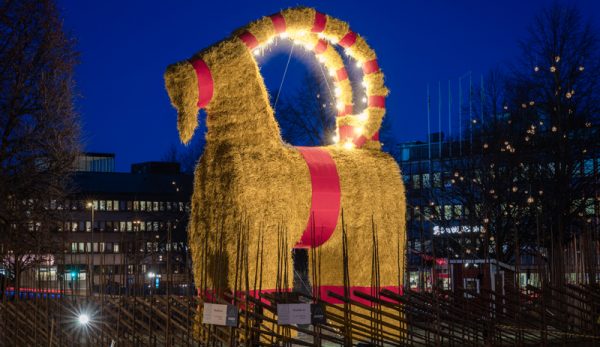
The Yule Goat signals the start of the holidays in Scandinavian countries (including Sweden, Norway and Finland) and some communities stateside with the building of the Gävle Goat in Sweden.
The plaited straw Yule Goat trimmed with red ribbons comes in all sizes, from palm-sized ornaments to the gigantic 42.6 tall, 3.6 ton Gävle Goat.
Find out more about this seasonal tradition…
Labor of Love
Construction of the Gävle Goat begins on the first day of Advent and takes 1,000 man-hours to complete. The materials are as impressive as the labor needed to build it.
On average the city’s tourism board says the Gävle Goat requires:
- 50+ feet of rope
- 12,000 knots
- 3,937 feet of pine crate to create the skeleton
- A truckload of straw
- An estimated cost of $249,900 (based on 2016 estimates)
Read more: Still wondering what to get the farmer in your life? Here are some ideas!
The Gävle Goat
The tradition started in 1966, according to Gävle’s tourism board.
Stig Gavlén had a marketing idea—a supersized version of the beloved figure-sized Yule goat could be built to attract customers to the area shops and restaurants. It worked locally and has gained world-wide renown, attracting 42,000 visitors in 2015 alone.
The intent is to leave the goat on display until New Year’s Day. But watching to see if the goat lasts until New Years has become an integral part of the ritual.
To date, it has been hit by a car, run through with a stake and suffered several fires. Kidnappings have also been planned. To date, only about half of Gävle Goats built since 1966 have survived the entire holiday season.
Ancient Roots
Much of the Yule goat’s origin has been lost in time. It is tied to the ancient pagan festivals that celebrated the Norse god Thor, who traveled by flying chariot pulled by two goats—Tanngrisnir (Gap-Tooth) and Tanngnjóstr (Tooth-Grinder).
The chariot delivered food for the god and his friends. Thor repeatedly slaughtered and ate the goats (they were returned to life the next morning).
In ancient midwinter celebrations, a man dressed in goatskins and wearing a mask to portray Tanngrisnir and Tanngnjóstr visited houses in Sweden and was symbolically killed but returned to life, exactly as the sun does at Yule.
Christian fathers disapproved of the pagan merriment and branded the (“Yule goat”) a demon.
Swedish records dating to the 17th century depict a gloomier version of the Yule goat—one that visited houses to steal food and play pranks. Over time he evolved into a compassionate figure and gave gifts rather than claiming them.
Another theory is that it was once affiliated with Indo-European harvest celebrations. According to the Carnegie Museum of Natural History, “ The last sheaf of grain bundled was believed to contain the spirit of the harvest and was saved for Yule celebrations—many early European customs included harvest gods that looked like goats. Farmers often referred to their bundles as goats because of the resemblance.”
Read more: These three recipes for holiday treats will help you share the holidays with your chickens!
A Global Goat
Regardless of its beginnings and evolution through time, the Yule goat has become a permanent representation of the annual holiday festivities around the world.
And through the exchange of cultural traditions, the Yule goat has even made its way to the U.S.
A smaller-scale version of the Gävle Goat has sporadically appeared in small Wisconsin communities since the mid-1800s. The Old World Wisconsin outdoor museum built and featured Yule goats in at least two of its annual events.
Want to get involved with the custom? It’s also possible to build your own Yule goat. Instructional videos on YouTube offer tips for building a skeleton, weaving straw and constructing a replica (size of your choosing) on your farm.
This article about the Yule Goat was written for Hobby Farms magazine. Click here to subscribe.




